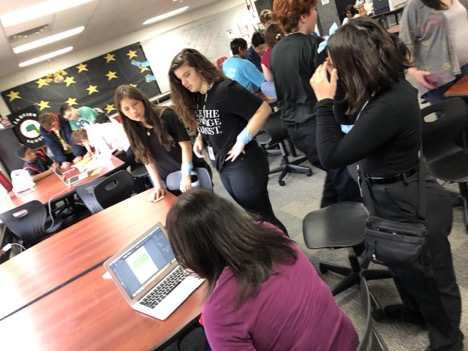Summary:
Janelle Bence of the Central Texas Writing Project shares lessons learned by both her and her students during the year-long Digital Democratic Dialogue Project.We all knew 3D (The Digital Democratic Dialogue Project) would be an invaluable opportunity for our students: the possibility for connection, learning about various contexts across the country, and gaining a deeper understanding of why people hold the views that they do. Perhaps, what we didn’t expect was the incredible lessons we, as educators, would also learn.
With a yearlong project, with such potentially polarizing topics, there’s so much needed in terms of creating a space where people feel safe yet inspired to push back when there’s need to prod for further information. But teachers are not the only ones encouraging empathy and respect while upholding norms and behaviors that sustain a healthy community of civic-minded people. Students also play an integral role in this community-building. As I reflect on everything that happened, I can say that 3D taught me as much if not more than it taught my learners.
This is an introduction of a series of articles of just some of the lessons learned alongside my learners and my colleagues. For each of the seven lessons, there will be separate texts about learners, context, activities, and work of my learners will be explored as well as how this lesson rang true for me.
-
We should get to know our neighbors.
When asking ninth graders to discuss which issues are important to them, the first step is exploring identity. This can feel like a risky undertaking. First, because teens at that age may have never reflected on their own identities. Second, because in reality, we all have multiple identities. Third, those identities seem like they are in constant flux as we navigate our multiple communities. Inviting students to numerous opportunities encourages familiarity and closeness necessary for the community.
-
Vulnerability is a 2-way street.
Asking students to share their honest views and opinions takes so much courage. Many of these perspectives come from fear of the unknown. The uncertainty of not knowing someone else, their thoughts, their reactions can result in unkind or unfair behavior. As difficult as this is, I knew I had to place myself in this same vulnerability.
-
Everyone has their stories.
Behavior hinges on experiences. We cannot separate someone’s biases or prejudices or values from their background, either in opposition or in support of upbringing. These stories have started, but in any relationship, the stories continue to develop taking twists and turns. What remains a constant was the notion of these stories continuing.
-
All relationships take work.
It’s not enough to plant seeds and leave those to grow on their own. There will be times when anyone in the community will feel alienated, other, different. With real honesty, these sentiments of potentially feeling alone and separate can happen. There’s a dance that comes with including while also celebrating diversity, but it’s a dance that needs continued practice. Getting to know one another and hearing one another’s stories doesn’t happen overnight. At times, people share only portions of their stories. Patience is essential to wait for people to have space to share their truths.
-
Patience is a virtue.
We all want change and transformation to happen as quickly as possible, but that’s just not how meaningful development happens. It takes time.
-
Nothing is perfect.
We all want everyone to respect one another. We dream of a world where everyone feels respected, included, and honored. But, that’s simply not reality. We are human. We are flawed, and that’s ok.
-
Hope is a choice.
Depending on the day, the time, the particular moment, we can look at this world and be disgusted, afraid, and even depressed. But hope can be found. It’s about where we look, where the stories start and end, whether we zoom in or zoom out. But there is always hope.

It was an exhausting time, and the 3D project continues to motivate me through its promise of continued learning. Most importantly, I understood the house or community I tried to build for my students would have never been built without sharing the design, construction, and maintenance by both myself and my learners. It will be a journey I will never forget. Yes, partially because the level of my own discomfort and uncertainty was heightened, but most of all because the mutual feeling of growth and development is something I will forever seek in all of my endeavors.

